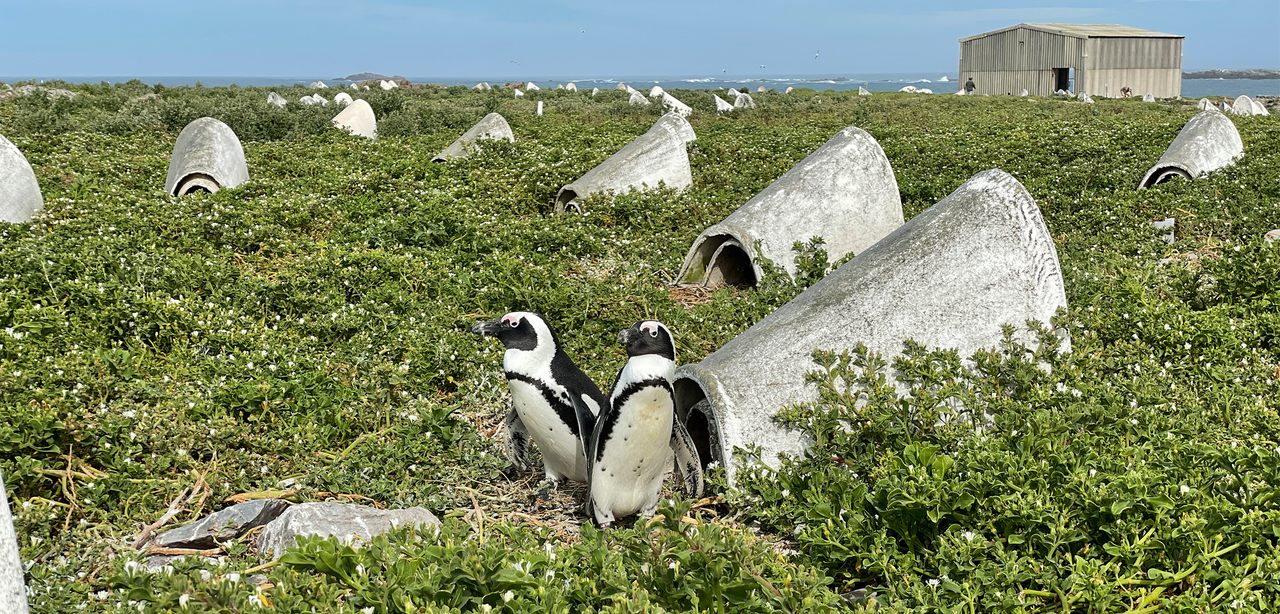South Africa’s Penguins May Beat the Heat With New Ceramic Nests
The artificial nests could shield the endangered seabirds from rising temperatures.
This article is from Hakai Magazine, an online publication about science and society in coastal ecosystems. Read more stories like this at hakaimagazine.com.
Scientists in South Africa have found that ceramic nest boxes can shield endangered African penguins from climate change.
In the past, the seabirds laid their eggs in burrows dug into centuries-old layers of their own excrement. But in the 1800s, most of the guano was scraped up by traders and shipped to the United Kingdom as fertilizer. Since then, many penguins have nested in the open, exposing themselves to heatstroke and their eggs and chicks to desiccation and predators. Shaun Welman, a zoologist at Nelson Mandela University (NMU), has seen penguins sitting with eyes shut, heads drooped, and beaks agape in the punishing midday heat, struggling to protect their eggs.
Because penguins evolved to retain heat in frigid water, they can easily overheat on land. Typically, penguins leave their nests regularly to cool off in the sea, but without proper burrows, this leaves their eggs unprotected.
“We’ve now put this entire species at risk of extinction, essentially because of human exploitation and greed,” Welman says.
Since 1900, the African penguin population has fallen to a fraction of its former glory: a mere 48,000 birds, down from as many as three million.
Fortunately, a team of researchers and conservationists working under the banner of the African Penguin Nest Project seems to have hit on a solution. Over the past four years, the team has designed and deployed more than 1,500 handmade ceramic nest boxes in five penguin colonies including Bird Island, located in Algoa Bay, an area that is home to nearly half of the world’s remaining African penguins.

A new study coauthored by Welman shows that the ceramic design provides the best nests on Bird Island. The artificial nests are even cooler than the penguin’s own guano burrows, a tiny number of which still survive.
Welman and colleague Lorien Pichegru, the acting director of the Institute for Coastal and Marine Research at NMU, found that older artificial nests made of cement get too hot. Inside, temperatures at times exceeded 40 degrees Celsius (104 degrees Fahrenheit) and occasionally even 50 degrees Celsius (122 degrees Fahrenheit), putting eggs at risk of overheating. In previous research, Pichegru also documented perilously high temperatures in artificial nests crafted from fiberglass.
But the new ceramic nests, made of two molded shells of gray fabric soaked in a ceramic slurry and fitted together to look like a tiny igloo, kept the birds cool.
The ceramic nests remained around 1 degree Celsius (1.8 degrees Fahrenheit) lower than a penguin’s resting body temperature of 37.6 degrees Celsius (99.7 degrees Fahrenheit), while humidity stayed above a comfortable 70 percent. The nests were so effective, Welman says, that “if adults had to abandon nests for whatever reason, the eggs would never be at any risk of overheating.”
Even in milder weather, the new nests make a difference. In a separate experiment, on a sunny 25 degrees Celsius (77 degrees Fahrenheit) day, the African Penguin Nest Project team logged temperatures of nearly 51 degrees Celsius (123.8 degrees Fahrenheit) on the ground outside a ceramic nest box and just 23 degrees Celsius (73.4 degrees Fahrenheit) inside.

The discovery of a viable artificial nest could not have come soon enough since it appears that African penguins are even more sensitive to direct sun than previously thought. On Bird Island, Welman and Pichegru saw birds panting in an effort to cool down in temperatures as low as 22 degrees Celsius (71.6 degrees Fahrenheit). With climate change, birds nesting in exposed areas will increasingly be subjected to dangerous conditions.
Christina Hagen of BirdLife South Africa, who was not part of the study, says the results show that ceramic nests are a potentially useful conservation tool. “Finding effective conservation solutions is vital given the dire status of the African penguin population,” she says.
The main threat to African penguins is overfishing of anchovy and sardines, the seabirds’ favored prey. Scientists and conservationists are pushing the South African government to close commercial fishing around six African penguin breeding colonies until populations recover. But without refuge from rising temperatures and predators on land, those efforts alone may not be enough. Ceramic nests could help to give these beloved seabirds a fighting chance.



























Follow us on Twitter to get the latest on the world's hidden wonders.
Like us on Facebook to get the latest on the world's hidden wonders.
Follow us on Twitter Like us on Facebook